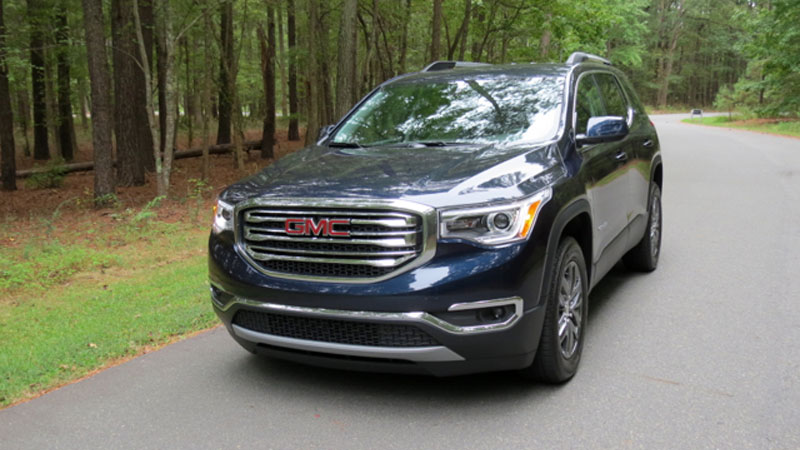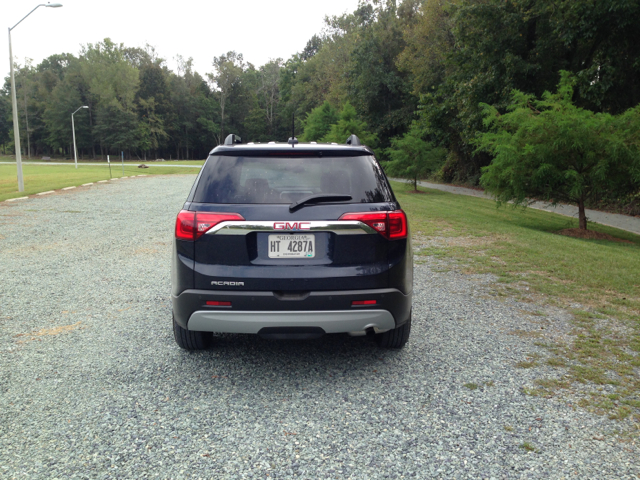GMC’s midsize SUV lighter, smaller, & more efficient than the previous model.
Eleven years is an awfully long time to stick with the same model. Typically, customer appeal fades after a few years. Even with product refreshes it usually requires a clean sheet design to reinvigorate consumer interest and the sales boost that goes with it.
The GMC Acadia flies in the face of marketing convention as its best year was 2015 when this midsize crossover sport utility vehicle was in its tenth year. This calendar year (2016) is one of transition as the first-generation model has given way to the second-generation Acadia. The new model went on sale in May.
Related: 2017 GMC Acadia Denali Review
Lighter Weight, Fresh Design
Big changes accompany the second-generation GMC Acadia. For one, it comes in at least 700 pounds lighter than the previous model. GMC says they accomplished the weight savings in part by using a body structure composed of press-hardened, high-strength steels.
It also helps that the base engine is now a four cylinder and the overall length has shrunk by 6.4 inches (3.5 inches between the wheels).
Gone is the previous eight-passenger seating option. The new model offers room for five, six, or seven, including exclusive two-row seating in the Acadia All Terrain, which brings in underfloor bins for added storage. In all other models, the 50-50 split folding third-row seat folds flat, creating a fully loading flat load floor behind the rear seat.
A new model means a fresh look and GMC has worked diligently to ensure that the latest interpretation pays off. Yes, you can still purchase a bling-bling Denali, while the blacked-out All Terrain serves as the antithesis of that look.
Regardless of the trim chosen, you’ll come away with an SUV offering a bold grille, sleek wraparound headlamps, a sporty lower grille opening, and strong shoulders. This model is also marked by squared wheel arches, a high belt line, alloy wheels, and oversized rear combination lamps.
Body sculpting, character lines, and a wraparound greenhouse look at the rear are other standout features.
Eight Trims for the Choosing
Most shoppers will choose one of the five standard trims for the 2017 Acadia: SL ($29,995), SLE-1 ($33,375), SLE-2 ($35,995), SLT-1 ($39,275), or SLT-2 ($42,675). Prices include destination; add $2,000 for all-wheel drive, where available. The base model is front-wheel drive only.
Choose the Denali and you’ll pay $45,845 (all-wheel drive is extra) while the All Terrain will set you back by $39,115 or $43,250 for the fully-optioned model. Terrain models come with an advanced all-wheel drive or 4×4 system, enabling customers to switch between various drive modes, including all terrain, sport, and trailer/tow.
Technology You Want

Voice, touchscreen, knob or switch operated, this model offers standard OnStar with Wi-Fi (a three-month trial subscription is offered) along with Apple CarPlay and Android Auto compatibility. These are the types of tech features customers want that go beyond the requisite USB ports and auxiliary audio ports to deliver a complete and entirely usable experience.
Safety is an important component of the customer buying experience. Beyond the suite of eight airbags, traction and stability control, and electronic brake-force distribution, there are certain advanced safety technologies customers want as well.
For the 2017 Acadia, the advanced driver assist technologies appear beginning on the SLT-2 level. These include: following distance indicator, forward collision alert, front pedestrian braking, lane keep assist, rear cross traffic alert, and side blind zone alert with lane change alert.
At this trim level, you’ll also receive front and rear park assist. As for crash testing, those results were not ready at the time of publication.
Standard equipment includes keyless entry and push-button start, a tilt and telescopic steering column, a leather-wrapped steering wheel, power accessories, cruise control, a rearview camera, air conditioning, OnStar 4G LTE and built-in Wi-Fi hotspot, Bluetooth connectivity, USB ports, an auxiliary jack, and a six-speaker audio system.
Upgrades are many and depend largely on the trim level chosen or the package acquired. These include an eight-speaker Bose audio system (SLT), remote vehicle start (SLE-2), a power driver’s seat (SLE-2), a heated power-adjustable steering wheel and column (Denali), driver alert package (SLT-1), and a 120-volt outlet (SLT-1).
You’ll also find many exterior and safety upgrades as you move up through the trim levels.
On the Road
Our Acadia SLT-1 test vehicle came with the 2.5-liter four-cylinder engine and front-wheel drive. There is a big difference in power numbers between the two, a point customers should be aware of when considering their vehicle.
The base engine makes 193 horsepower and 188 pound-feet of torque. The V6 has an output of 310 horsepower and 271 pound-feet of torque. Both engines are paired with a six-speed automatic transmission.
The four-cylinder engine makes this SUV feel light on its feet. In front-wheel drive you’ll sense the overall lightness —for some customers, this combination will suit them fine. On the other hand, if it is full trailering capabilities you prize, the base engine won’t be sufficient as it is limited to 1,000 pounds.
Choose the V6 and the trailer towing package enables this SUV to reach its maximum 4,000-pound trailering capacity.
Step on the accelerator and the GMC moves away evenly from a full stop. No, you won’t find rapacious amounts of power, but it gets the job done. This model was developed when fuel prices were still high, thus the smaller standard engine.
You’ll benefit from a fuel economy edge too, as the standard model makes 21/26 mpg city/highway while the V6 delivers 18/25 mpg city/highway.
One surprise for me was the transmission choice. Given that eight-speed transmissions are more commonplace in today’s vehicles, including with GM products, I was surprised to find that a six-speed automatic is still used.
The two extra cogs would have provided slightly better fuel economy and improved off-the-line acceleration. Despite limited to six gears, this proven transmission works seamlessly in the background.
What then should be the measuring criteria when choosing your Acadia engine? It boils down to this: load capacity. Choose the smaller engine if you’re purchasing this SUV and you have a young family — you, your spouse, and a pair of small children. Families with teenagers, people who regularly carry cargo and especially anyone disposed to towing will require the V6.
In any case, the 2017 Acadia offers a comfortable ride with minimal body roll when cornering. For optimum comfort, performance and ride, a Denali model is your best choice. Go with one of the All Terrain packages if off-road prowess is important to you.
Parting Thoughts
The 2017 Acadia replaces a very capable model — that alone was a tall order for vehicle developers. Its smaller footprint and improved efficiency work to deliver a midsize SUV with improved handling.
For shoppers preferring something slightly smaller, the GMC Terrain should be considered. For those wanting more room and the V8 power and trailering capabilities that come with it, the Yukon or Yukon XL should be considered.
Lastly, if you’re shopping at a combined Buick-GMC showroom, the Buick Enclave is available. It is based on the Acadia’s older design with the new model set to reach the market for the 2018 model year. In all, you’ll find no lack of SUV’s available — four GMCs and three Buicks — with the Acadia the newest of the lot.
Recent Review – Tiny Cargo Transporter: 2016 Nissan NV200
Photos copyright Auto Trends Magazine. All rights reserved.
- 2024 Mazda CX-50: A Compact SUV with Premium Aspirations - Apr 15, 2024
- 2024 Ford Mustang (Iconic Pony Car Evolves) - Apr 4, 2024
- 2024 Ford Maverick (Looks Like a Truck, Drives Like a Car) - Mar 28, 2024





